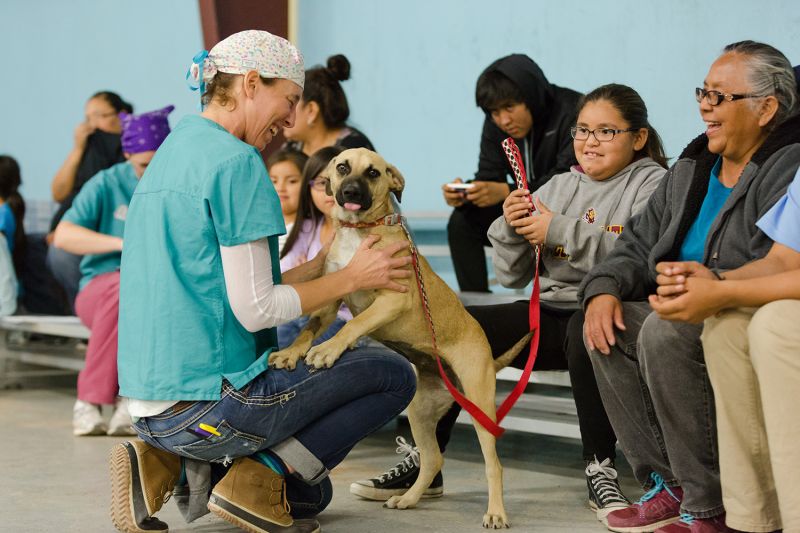Blog: States must lift restrictions on telemedicine
Veterinary telemedicine saves lives, alleviates suffering and preserves the human-animal bond
June 12, 2023

Terrier-mix puppies Spotty and Panda were thriving under the care of a young boy and his grandfather until April 2021, when Panda passed away suddenly. Over the next five days, Spotty became less interested in eating and drinking, was wheezing and breathing rapidly, and wouldn’t get up or walk around.
Spotty’s family didn’t have the resources to take him to the nearest veterinarian, more than 60 miles away from their home on the reservation of the San Carlos Apache Tribe, which shares geography with the state of Arizona. So they contacted the Geronimo Animal Rescue Team, a local rescue group that partners with Rural Area Veterinary Services.
At the time, Arizona had temporarily lifted restrictions on veterinary telemedicine due to the COVID-19 pandemic. This meant that even though I’d never met Spotty, I was able to assess his condition remotely by talking to his family on the phone and exchanging videos, photos and information through text messages. With my support and guidance, his family was able to show and tell me about his symptoms, check his gum color, and measure his respiratory and heart rates.
Knowing that there was an extremely high prevalence of tick-borne diseases in both humans and dogs in the community, I made a tentative diagnosis and prescribed an antibiotic recommended for tick diseases, which GART volunteers delivered to the family. Spotty was mildly improved in 24 hours and back to normal in 48 hours, consistent with the recovery process for tick disease. Without prompt antibiotic treatment, he could have died from the same illness that likely killed his brother.
As we saw in cases like Spotty’s and many others, veterinarians can use telemedicine to increase access to care without jeopardizing professional integrity or the well-being of animal family members.
Since 2003, RAVS, which is a program of the Humane Society of the United States, has worked to expand access to veterinary care in underserved rural communities where a lack of resources and geographic isolation make regular animal health services unavailable. At weeklong field clinics, our team brings spay/neuter and other medical care to animal family members in the host communities, and we partner with local pet assistance programs. It’s a much-needed service, but since we can’t be everywhere at once and local resources are typically limited, veterinary care remains a challenge for dogs and cats who need immediate treatment and can’t wait for our next field clinic.
For many families in the host communities, vet care is simply unaffordable, or they lack a way of transporting their animal family members to the nearest veterinary hospital, which is often many miles away. Some can’t take a day off work for a trip to the veterinarian; others are caregivers and have no one to look after their children or elders for an extended period of time. And even if they’re able to surmount all these barriers, they typically have nowhere to go should their animal need emergency treatment when the nearest vet clinic is closed.
At the height of the pandemic, when governors in several states issued executive orders expanding access to veterinary telemedicine, the RAVS team experienced firsthand how technology can save lives, alleviate suffering and preserve the human-animal bond for some of the most vulnerable people and pets in our society. For some cases, a virtual diagnosis and medication were enough to restore the animal to full health. For others, telemedicine was a stopgap that enabled families to provide supportive care until they could line up the money and transportation needed to get their animal family member to a local veterinarian.
But as the pandemic subsided and the executive orders ended, most states reverted to their normal restrictions on virtual veterinary care, including rules surrounding what’s known as the VCPR (veterinarian-client-patient relationship). In most states, veterinarians can’t diagnose or treat an animal unless they’ve already established a VCPR by conducting a hands-on exam of the animal. Many states require a VCPR to be established not just for each animal but also for each medical condition and set limits on how long the VCPR remains in effect.
That leaves veterinarians in a moral quandary: We can provide telemedicine to animals in dire need and risk our license, or we can withhold care from these animals, knowing that their families have no other options. It’s an impossible choice and adds to the stress and emotional burnout too many veterinary professionals experience.
Fortunately, state legislatures are waking up to the fact that with a growing national veterinary workforce shortage, we can’t afford to limit veterinarians’ use of modern technology. In May, Arizona enacted a law that allows VCPRs to be established electronically with certain conditions. Similar legislation has been introduced in California and New York, and we hope to see bills introduced in other states in the near future.

For the families that RAVS serves, change can’t come soon enough. Without access to veterinary services, animals suffer from injuries, live with untreated chronic illnesses and die needlessly from treatable infections. Their families experience emotional distress as they desperately but unsuccessfully attempt to nurse their animal family members back to health, and the community as a whole suffers when people are exposed to zoonotic and vector-borne illnesses.
It doesn’t have to be this way. As we saw in cases like Spotty’s and many others, veterinarians can use telemedicine to increase access to care without jeopardizing professional integrity or the well-being of animal family members.
After Spotty recovered from the tick-borne disease, his family saved up to get him vaccinations at a local feed store and was able to get a long-acting tick preventative for free from their local animal control agency. A few months later, his family brought him to a RAVS field clinic in his community for a yearly checkup. Thanks to telemedicine, Spotty is now a happy, healthy adult dog.


